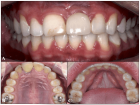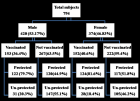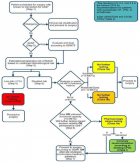About Tripoli University
Tripoli University
Articles by Tripoli University
Oral Candida colonization in HIV-infected patients: Species and antifungal susceptibility in Tripoli/Libya
Published on: 3rd August, 2018
OCLC Number/Unique Identifier: 7844539006
Introduction: Candidiasis is more frequent in human immunodeficiency virus (HIV)-infected patients and knowledge about the distribution and antifungal susceptibility of oral Candida species is important for effective management of candidiasis.
Material and Methods: An oral rinses sample collected from hundred HIV-infected patients with and without clinical evidence of oral candidiasis in this study at the Infectious Department/Tripoli Medical Center, Libya. Species identified by standard phenotypic and conventional methods and in vitro susceptibility testing of the yeast isolates to antifungals were performed using the Disc diffusion method protocol as recommended by the Clinical Laboratory Scientific Institute.
Results: Oral Candida colonization is detected in all patients with and without clinical syndromes, and Candida albicans were accounted for (74%), C. dubliniensis (11%) and C. glabrata (6%). A high proportion of Candida species (42%) showed decreased susceptibility to fluconazole. Among C., albicans more than 30% of isolate were resistant to most new azole antifungal including fluconazole, itraconazole, posoconazole and voriconazole.
Conclusions: A significant number of oral Candida species particular Candida albicans exhibiting decreased susceptibility to fluconazole were isolated from colonized HIV-infected individual, given the high incidence and severity of fungal infections in HIV-infected individuals. The results of this study reinforce the importance of antifungal susceptibility testing, which contributes to the therapeutic strategies and highlights the need for continuous surveillance of Candida colonization in this population.
Evaluation of novel culture media prepared from plant substrates for isolation and identification of Cryptococcus Neoformans Species Complex
Published on: 14th August, 2018
OCLC Number/Unique Identifier: 7844645048
Background: Melanin production due to phenoloxidase activity is a distinctive property of Cryptococcus neoformans and Cryptococcus gattii species complex yeasts. Therefore, an agar medium containing a precursor of melanin pigment is potentially useful to identify and differentiate cryptococcal colonies from other yeasts.
Background: This study aimed to evaluate and compare the ability of Cryptococcus neoformans species complex isolates to produce brown-pigmented colonies when grown on media prepared from various plant leaves or seeds extracts.
Material and Methods: Forty-six C. neoformans species complex isolates which were obtained from various environmental and clinical samples were inoculated on different media containing coriander, cumin, soybean, lupine, flax, pumpkin, basil, peppermint, and marjoram, were observed for the rate of growth and pigment production during a five-day period.
Results: All isolates were pigmented on all media within 24-48 hours, and brown or dark brown colonies were observed in less than five days, while C. albicans grew but did not produce any pigment.
Conclusion: The differential media tested in the present study are simple and inexpensive, and represent alternative valid tools for presumptive identification of C. neoformans species complex from clinical and environmental samples
Screening of antibiotic residue in poultry in Kathmandu valley of Nepal: A cross-sectional study
Published on: 27th September, 2019
OCLC Number/Unique Identifier: 8286596940
This cross-sectional study was conducted to screen the presence of antibiotic residue in poultry. A total of 60 samples (30 Muscle and 30 Liver) were taken from local meat shops from different parts of Kathmandu valley. Disc assay method was used. Escherichia coli (ATCC 25922) and Staphylococcus aureusi (ATCC 25923) were used as test organisms. The results revealed 8 positive samples (which is 13%). Among 30 Liver samples, 3 showed positive result, while only 2 muscle sample indicated positive result. Muscle has the highest percentage of positive results than liver. For S. aureus showed greater percentage of positive results than that of E. coli. The presence of antibiotic residue and its many pathological effects to public health demands the strict rules and regulations as well as surveillance from the concerned authorities.
Overview of glycemic control among admitted patients with diabetes in Tripoli University Hospital
Published on: 18th February, 2022
Aim: To examine the relationship between the levels of HbA1c and hospital admission rates.Methods: We recorded HbA1c levels of all diabetic patients in Tripoli University Hospital over one year.Results: The mean HbA1c was 8.03%, with no difference between males and females. Over half of patients (56.5%) were admitted through their diabetes was well-controlled. Over half of the patients with type 1 diabetes (57/102, 55.9%) had a high HbA1c at admission compared to 42.1% of patients with type 2, who were mainly admitted with HbA1c level within the acceptable range set for this study. The HbA1c level was positively and significantly correlated with the length of hospital stay (R = 0.93, p = 0.000), and was significantly associated with hyperglycemia, diabetic ketoacidosis, coronary artery disease, limb ischemia, cataract, osteomyelitis, and non-alcoholic steatohepatitis.Conclusion: HbA1c is correlated significantly with hospitalization in type 1 diabetes but not in type 2.
Approximation of Kantorovich-type Generalization of (p,q) - Bernstein type Rational Functions Via Statistical Convergence
Published on: 19th March, 2024
In this paper, we use the modulus of continuity to study the rate of A-statistical convergence of the Kantorovich-type (p,q) - analogue of the Balázs–Szabados operators by using the statistical notion of convergence.Mathematics subject classification: Primary 4H6D1; Secondary 4H6R1; 4H6R5.

If you are already a member of our network and need to keep track of any developments regarding a question you have already submitted, click "take me to my Query."




















































































































































